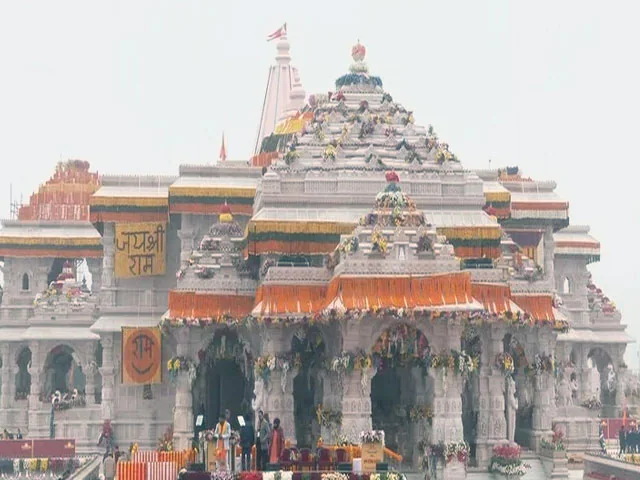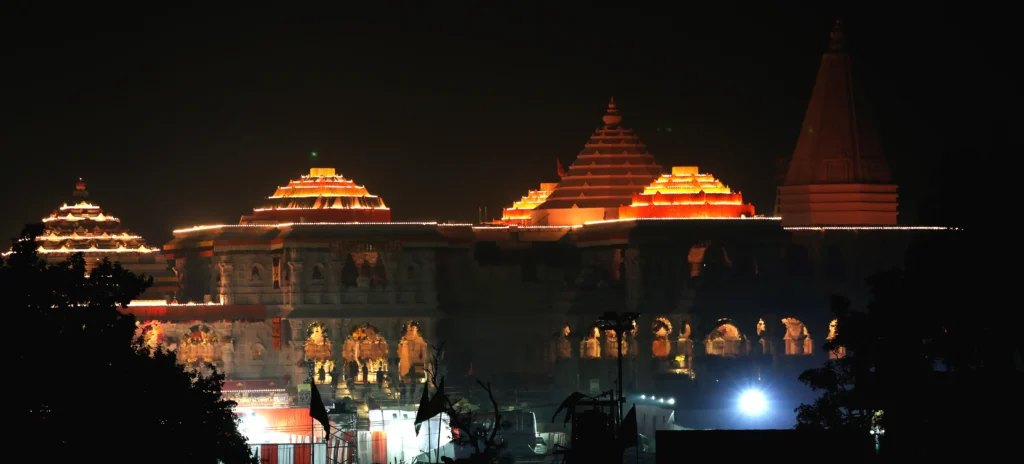Historic Inauguration:
In a momentous event that resonates with the heartbeat of millions across the nation, Prime Minister Narendra Modi graced the consecration ceremony of the Ram Temple in Ayodhya. PM At Ram Temple Inauguration, a culmination of a 50-year-long dream for many and a significant milestone for the BJP. Unfolded amidst a backdrop of religious fervor and cultural celebration.
Religious Significance:
As the sun illuminated the holy city, the consecration ceremony, known as ‘Pran Pratishtha,’ commenced with the placement of the idol of five-year-old Lord Ram at the sanctum sanctorum. This auspicious occasion, akin to a Diwali celebration, marked the homecoming of Lord Ram after the legendary battle with Ravan. Temples and households adorned with festive lighting added to the jubilant atmosphere. Creating an ambiance reminiscent of the divine triumph.
PM Modi’s Spiritual Observance:
PM At Ram Temple Inauguration. Embodying the spirit of the occasion. Had diligently observed a series of strict 11-day religious rituals leading up to the consecration ceremony at noon. His presence at the event was not merely symbolic; it underscored the deep cultural and spiritual significance that the Ram Temple holds for the nation.
Inclusive Participation:
The historic Pran Pratishtha ceremony saw the participation of representatives from major spiritual and religious sects across the country. Notably. People from diverse walks of life. Including representatives from various tribal communities. Added to the tapestry of unity and inclusivity woven into this grand event.
Acknowledging Laborers:
Prime Minister Modi, in addition to addressing the gathering, took a moment to interact with the laborers who had tirelessly contributed to the construction of the Ram Temple. This gesture not only acknowledged their hard work but also symbolized the collaborative spirit that brought this architectural marvel to life.
Architectural Marvel:
The Ram Temple, standing at an impressive 380×250 feet, is a testament to India’s rich architectural heritage. Built in the traditional north-Indian Nagara style, the temple boasts 392 pillars, 44 doors, and walls adorned with intricate carvings depicting gods and goddesses. The meticulous design and craftsmanship reflect the cultural ethos embedded in every stone and carving.
Unique Construction:
A unique aspect of this architectural masterpiece lies in its construction without the use of iron and steel. This deliberate decision, explained by Shri Nripendra Misra, the chairperson of the temple construction committee, was driven by the desire for longevity. Unlike materials with limited lifespans, the temple’s construction relied on top-notch Indian scientific expertise, including contributions from the Indian Space Research Organisation (ISRO).
Challenges in Foundation:
The foundation of the temple presented a formidable challenge due to the sandy and unstable soil beneath. Ingenious solutions were employed, including excavating the soil to a depth of 15 meters and replacing it with engineered soil. Importantly, no steel re-bars were used, and a 47-layered metal-free concrete raft reinforced the foundation, creating a rock-like stability.
Quality Construction Materials:
Dr. Pradeep Kumar Ramancharla, the Director of the Central Building Research Institute in Roorkee, shed light on the construction materials. The temple predominantly features the finest quality granite, sandstone, and marble. The visible part of the temple, constructed with pink sandstone from Rajasthan, exudes a distinct charm. The sanctum sanctorum, adorned with white Makrana marble, shares a material connection with the iconic Taj Mahal.
Structural Integrity:
The structural design of the temple underwent meticulous analysis through around 50 computer models. This ensured not only its aesthetic appeal but also its ability to withstand seismic activities. The Central Building Research Institute (CBRI), actively involved in the construction, contributed to the ‘Surya Tilak’ mechanism, design vetting of the temple foundation, and structural health monitoring.
Controversies and Opposition:
As the temple stands tall, it is more than a physical structure; it is a symbol of India’s enduring spirit. The architects and scientists involved have not just constructed a temple; they have crafted a timeless masterpiece that resonates with the soul of the nation. The Ram Temple, with its architectural grandeur and scientific precision, stands as a testament to India’s rich legacy and its ability to seamlessly weave tradition into the fabric of progress.
In the lead-up to the inauguration, Ayodhya underwent a transformative journey. The city, deeply entwined with the tapestry of Indian cultural and religious heritage, witnessed the culmination of efforts to prepare for the grand event. With an international airport, a renovated railway station, and a surge in accommodation facilities, Ayodhya welcomed over 11,000 visitors, signaling a long-awaited economic boom.
However, the event was not without its share of controversies. Opposition parties, including the Congress, Left, Trinamool Congress, and the Samajwadi Party, chose to distance themselves from the inauguration. Accusing the BJP of exploiting religion for political gain in an election year, they decided to keep their participation at bay.
The BJP, in response, condemned the decision of those who declined the invitation, branding them as anti-Hindu. The political discourse around the event revealed deep fault lines in India’s diverse political landscape.
Criticism from Shankaracharyas:
The event also faced criticism from certain quarters, including the Shankaracharyas of four premier monasteries, who chose to stay away. Their concerns centered around the consecration of an incomplete temple and the alleged politicization of the event. Questions were raised about the seating arrangement, with the Shankaracharyas allotted seats outside the sanctum sanctorum.
Supreme Court Verdict:
The construction of the Ram Temple commenced following a landmark Supreme Court judgment in 2019. The verdict awarded the disputed land for the temple and directed the allocation of an alternate plot for a mosque to the Muslim community. The decades-long dispute, rooted in history and religion, took a significant turn with the apex court’s decision.
In 1992. The site gained notoriety when hundreds of Karsevaks razed a 16th-century mosque. Believing it was built over a temple marking the birthplace of Lord Ram. The incident triggered a series of legal battles that ultimately found resolution in the Supreme Court’s judgment.
Symbol of Unity:
As Ayodhya’s Ram Temple stands tall, it symbolizes more than just a physical structure. It embodies the enduring spirit of India’s cultural and religious heritage—a harmonious blend of tradition and modernity. The architects and scientists have not only created a temple but a legacy that will resonate for generations to come. The Ram Temple, with its architectural grandeur and historical significance, stands as a beacon, guiding the nation towards a future that seamlessly integrates its rich heritage with the promise of progress.
Also read : The Construction of Ayodhya’s Ram Mandir Without Iron and Steel”
PM Modi’s Presence:
In the heart of Ayodhya. The architectural marvel of the Ram Temple now stands as a living testament to India’s ability to craft its destiny with the wisdom of the past and the vision for the future. As Prime Minister Modi graced the inauguration. He not only participated in a historic event but also marked a moment of unity. Spirituality, and collective pride for the entire nation. PM At Ram Temple Inauguration. His presence spoke volumes about the cultural ethos that defines India—a diverse yet unified tapestry woven with threads of tradition. Spirituality. And progress.







